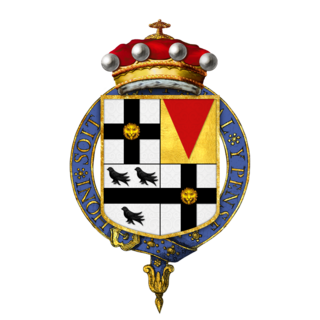| Vice Admiral of Gloucestershire | |
|---|---|
| Active | 1559-1835. |
| Country | |
| Branch | |
| Type | Naval administration |
| Role | and Naval Jurisdiction. |
The Vice-Admiral of Gloucestershire [1] was responsible for the defence of the county of Gloucestershire, England.
| Vice Admiral of Gloucestershire | |
|---|---|
| Active | 1559-1835. |
| Country | |
| Branch | |
| Type | Naval administration |
| Role | and Naval Jurisdiction. |
The Vice-Admiral of Gloucestershire [1] was responsible for the defence of the county of Gloucestershire, England.
As a vice-admiral, the post holder was the chief of naval administration for his district. His responsibilities included pressing men for naval service, deciding the lawfulness of prizes (captured by privateers), dealing with salvage claims for wrecks and acting as a judge.
The earliest record of an appointment was of Edmund Brydges, 2nd Baron Chandos 1559–1573.
In 1863 the Registrar of the Admiralty Court stated that the offices had 'for many years been purely honorary' (HCA 50/24 pp. 235–6). Appointments were made by the Lord High Admiral when this officer existed. When the admiralty was in commission appointments were made by the crown by letters patent under the seal of the admiralty court. [2]
This is a list of people who have served as Vice-Admiral of Gloucestershire .
There has been a Lord Lieutenant of Buckinghamshire almost continuously since the position was created by King Henry VIII in 1535. The only exception to this was the English Civil War and English Interregnum between 1643 and 1660 when there was no king to support the Lieutenancy. The following list consists of all known holders of the position: earlier records have been lost and so a complete list is not possible. Since 1702, all Lord Lieutenants have also been Custos Rotulorum of Buckinghamshire.
This is a list of people who have served as Lord Lieutenant of Gloucestershire. Since 1694, all the Lord Lieutenants have also been Custos Rotulorum of Gloucestershire.

Vice-Admiral James Berkeley, 3rd Earl of Berkeley, was an English Royal Navy officer and peer who served as First Lord of the Admiralty from 1717 to 1727. The son of Charles Berkeley, 2nd Earl of Berkeley, he was known by the courtesy title of Viscount Dursley prior to succeeding as Earl of Berkeley in 1710.
This is a list of people who have served as Custos Rotulorum of Gloucestershire.
This is a list of people who have served as Custos Rotulorum of Somerset.
The holder of the post Vice-Admiral of Cumberland was responsible for the defence of the county of Cumberland, England.
The holder of the post Vice-Admiral of Devon was responsible for the defence of the county of Devon, England.
Gentleman of the Bedchamber was a title in the Royal Household of the Kingdom of England from the 11th century, later used also in the Kingdom of Great Britain. A Lord of the Bedchamber was a courtier in the Royal Household; the term being first used in 1718. The duties of the Lords and Gentlemen of the Bedchamber originally consisted of assisting the monarch with dressing, waiting on him when he ate, guarding access to his bedchamber and closet and providing companionship. Such functions became less important over time, but provided proximity to the monarch; the holders were thus trusted confidants and often extremely powerful. The offices were in the gift of The Crown and were originally sworn by Royal Warrant directed to the Lord Chamberlain.
The Vice-Admiral of the coast of Durham was responsible for the defence County Durham, England.
The Vice-Admiral of Dorset was responsible for the defence of the County of Dorset, England.

Edmund Brydges, 2nd Baron Chandos was an English peer and politician. He was a Knight of the Garter, Baron Chandos, Lord Lieutenant of Gloucestershire and Vice-Admiral of Gloucestershire.
{{cite web}}: CS1 maint: bot: original URL status unknown (link)